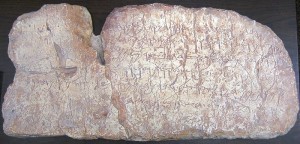
When skeptics claim that Bible believers are biased, they are right. The truth is we all are biased, skeptics included. Some may be more aware of their own bias than others, but we all have our biases.
I am fascinated with stories of people who had one “bias” at one time and changed to the opposite “bias”. It happens both ways: atheist to believer/believer to atheist. Someday I will explore the similarities and the differences in those stories. There are some common threads, but that is a topic for another day.
In keeping with my bias, I am drawn toward things that confirm the veracity of the Bible, both as a historical document and as a spiritual guide – God’s revelation to man as well as God’s revelation to me. That does not mean that I am unwilling to test my bias by considering other things, contrary views. In fact, the more I look at the other side, the more confidence I have found in my own bias.
One of the things I have found (a common theme) is the selective focus of skeptics. I do not doubt that the same statement can be made about people of faith. In keeping with my own bias, I present a summary of different views on the dating of “Hezekiah’s tunnel” (a 533 meter (approx. 1748 ft.) tunnel). The summary is found at crossexamined.org.
The Bible references are these:
- It was Hezekiah who blocked the upper outlet of the Gihon spring and channeled the water down to the west side of the City of David. 2 Chronicles 32:30
- “As for the other events of Hezekiah’s reign, all his achievements and how he made the pool and the tunnel by which he brought water into the city, are they not written in the book of the annals of the kings of Judah?” 2 Kings 20:20
- “Then the Lord said to Isaiah, ‘Go out, you and your son Shear-Jashub,to meet Ahaz at the end of the aqueduct of the Upper Pool, on the road to the Launderer’s Field.'” Isaiah 7:3 (Shear-Jashub means a remnant will return.)
- “In the fourteenth year of King Hezekiah’s reign, Sennacherib king of Assyria attacked all the fortified cities of Judah and captured them. Then the king of Assyria sent his field commander with a large army from Lachish to King Hezekiah at Jerusalem. When the commander stopped at the aqueduct of the Upper Pool, on the road to the Launderer’s Field, Eliakim son of Hilkiah the palace administrator, Shebna the secretary, and Joah son of Asaph the recorder went out to him.” Isaiah 36:1-3
Modern archaeology continues to uncover evidence of places mentioned in the Bible. One thing I have noticed is this: when evidence supporting biblical accounts is discovered, skeptics sometimes “push the goal posts back” by questioning the date of the discovered place or thing in comparison to the chronology posited or suggested in the biblical text. In doing so, skeptics often overlook corroborating evidence by focusing too much on specific facts or questions to the exclusion of other facts or evidence – even facts or evidence from non-Biblical sources.
In the case of the Siloam Tunnel, the corroboration comes from Assyrian records kept at the Istanbul Archaeological Museum. The Assyrian historical records match exactly the time frame recorded in the biblical record. The full summary can be read here: Archaeology, the Bible & the Great Dating Debate

3 thoughts on “Bias is Revealed in What we Consider and Fail to Consider”